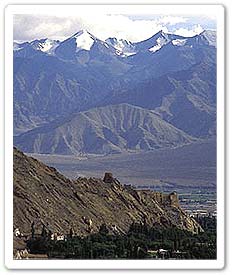Time to Visit : Any time of the year, depending on the place you have picked to visit.
Weather : From freezing cold to desert hot.
Indian States Covered : Jammu & Kashmir, Himachal Pradesh, Uttranchal, West Bengal, Sikkim, Assam, Arunachal Pradesh.
 The
Himalayas
The
HimalayasThe Himalayas or the 'Abode of Snow' stretches from Jammu & Kashmir in north India to Arunachal Pradesh in the extreme northeast India. The Himalayan Mountain Range bisects India from the rest of Asia by its invincible mountain ranges. Though, major range of Himalaya does not cover the entire northeast India, its smaller ranges extends into the remote parts of northeastern states of India, thus it also separates northeast India from the southeast Asian countries.
The Himalayan Topography
The billowy Himalayas beckons with lush green thickets in the foothills of Shivalik Ranges, snow covered Dhauladhar range over shadowed by the Pir Panjal Ranges and the Great Himalayan Ranges. The land is sprinkled by beautiful lakes and luxuriant valleys located between an altitude of 350 m and about 6,810 m, interlinked by rivers and sprawling valleys.
The forests, flora & fauna, and natural scenic beauty with salubrious climate is a haven for the visitors. The alpine land, spread over Lahaul and Spiti to Pangi valley, is an ardent destination for Aplinists and a feast of hedonists.
In Himalayas, medicinal herbs have been growing throughout the region since times immemorial. Adventure sport is another area of tourism activities, which yields greater scope for trekking, camping, mountaineering and skiing, etc.
Eco-tourism in the Great Himalayas
The Himalayan Wildlife
The Himalayan region exhibits great variety in wildlife resource. This is also the place, where rare medicinal herbs grow. In the Terai - the Himalayan foothills, there are luxuriant tropical forests of Sal, Teak and Shisham. As one climbs, one comes across a variety of Chir (Pine), Oak, Deodar, Fir, Rhododendron, Birch And Juniper. One also comes across rare and endangered species of animals and birds in this region. Some areas declared as National Park for the conservation and protection of wildlife in the Himalayan region are - Corbett National Park, Uttaranchal; The Great Himalayan National Park, Himachal Pradesh; Namdapha National Park, Arunachal Pradesh; The Royal Chitwan Park, Nepal.
The Himalayan Rivers
 Major Himalayan Rivers are - Indus, Sutlej, Ganga, Yamuna, Brahmaputra.
Rushing and bouncing along irregular surfaces and the beautiful meadows, the
numerous rivers that meanders through the Indian mainland are central to our
history as well as to Indian mythology. The major rivers of the Himalayan
group are the Indus, the legendary Ganga and the majestic Brahmaputra. These
rivers are fed by both snow and rain and therefore endlessly flow round the
year. Himalayan rivers discharge about 70% of their inflow into the sea.
This includes about 5% from central Indian rivers. They join the Ganga and
drain into the Bay of Bengal. These rivers of the Himalayan group are
inhabited by a large percentage of aqua lifes, creating a favourable
ecosystem for the freshwater creatures.
Major Himalayan Rivers are - Indus, Sutlej, Ganga, Yamuna, Brahmaputra.
Rushing and bouncing along irregular surfaces and the beautiful meadows, the
numerous rivers that meanders through the Indian mainland are central to our
history as well as to Indian mythology. The major rivers of the Himalayan
group are the Indus, the legendary Ganga and the majestic Brahmaputra. These
rivers are fed by both snow and rain and therefore endlessly flow round the
year. Himalayan rivers discharge about 70% of their inflow into the sea.
This includes about 5% from central Indian rivers. They join the Ganga and
drain into the Bay of Bengal. These rivers of the Himalayan group are
inhabited by a large percentage of aqua lifes, creating a favourable
ecosystem for the freshwater creatures. The Himalayan People
We learn from the most ancient Hindu scriptures that, the original inhabitants of the Himalayas were - the Kulinds, Kiratas and Kilinds, Kiratas and Kinnars and later texts mention the Khasas and the Darads as the inhabitants of the Himalayas. Today, three ethnic groups constitute the Himalayan population - Negroids, Mongoloids and Aryans.
Since very early times there have been migrations & settlements in and around the Himalayas. The continuous influx and inhabitation of the outsiders into this land over a period of time has significantly changed the complexion and appearance of the local populace. There have been waves of migration from Nepal to Sikkim and Kumaon, for instance, and from Tibet. At present, it is extremely difficult to differentiate the different racial lineage.
The Himalayan Hill Stations
The Himalayan hill stations are lush and vibrant. The salubrious climate and the rich natural resource beckons several naturalist, adventurer, environmentalist and biologist to this hidden treasure of the nature. The hill stations of the Himalayas are the abode of various kinds of rare flora & fauna. Every hill station located in this region represents something different from the other. Some major hill locations here are - Gulmarg & Sonamarg, Srinagar, Ladakh, Shimla, Kullu, Manali, Dharamsala, Dalhousie, Sarahan, Nainital, Mussoorie, Rishikesh, Gangtok, Darjeeling, Kailash Mansarovar






